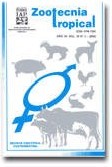
|
Zootecnia Tropical
Instituto Nacional de Investigaciones Agrícolas Venezuela
ISSN: 0798-7269
Vol. 29, No. 3, 2011, pp. 313-321
|
 Bioline Code: zt11029
Bioline Code: zt11029
Full paper language: English
Document type: Research Article
Document available free of charge
|
|
|
Zootecnia Tropical, Vol. 29, No. 3, 2011, pp. 313-321
| en |
Leucogram and protein profi le in dual purpose crossbred calves, resistant and susceptible to natural infection by gastrointestinal nematodes
Barrios, Mariana; Sandoval, Espartaco; Camacaro, Olga; Sánchez, Darwin; Domínguez, Luis & Márquez, Oswaldo
Abstract
This study was carried out to evaluate white blood cell count alterations (cell component) and the protein profi le
(humoral component) in dual purpose calves, categorized as resistant and susceptible, after exposure to infested
pastures. The study was conducted in 75 crossbred calves of both sexes (37 males and 33 females) from to
dual-purpose operating units of the municipality Manuel Monge, Yaracuy state of Venezuela. Animals were
divided into three age groups: ≤ 60 days, from 61 to 210 days, > 210 days and grouped according to their racial dominance as: Cebu, European, Carora. According to number of strongyle eggs per gram of feces (HPG) and
hematocrit (HTO), animals were classified as: resistant type I (R1) with HPG <700 and HTO> 30%, resistant
type II (R2 ) with HPG <700 and HTO <30%, subject to type I (S1) with HPG> HTO 700 and> 30% and
likely type II (S2) with HPG> HTO 700 and <30%. A blood sample was aseptically taken from all animals for
haematological evaluations and for serum and faeces sample for the coprologyc study. R1 and R2 groups showed
leukocytosis with lymphocytosis, moderate levels of eosinophils and normal values of totals proteins (PT) and its
fractions, unlike S1 and S2 groups which had normal leukocyte counts wit hout significant changes among types
and hypoproteinemia with decreased globulin fraction. Negative correlation was found between HPG and the
levels of leukocytes, lymphocytes, eosinophils, neutrophils, totals proteins and globulins. The racial dominance
for resistance to nematodes was: Carora> Cebu> European. The animals >210 days are the most resistant to
nematode infection, 26% for R1 and R2 52% (p<0.05). Group R2 are also the most susceptible animals to other
infections. Animals most susceptible to nematode infection are those with less than 60 days of age.
Keywords
leukocytes, protein, nematode, resistance.
|
| |
| es |
Leucograma y perfi l proteico en becerros mestizos doble propósito, resistentes y susceptibles a la infestación natural por nemátodos gastrointestinales
Barrios, Mariana; Sandoval, Espartaco; Camacaro, Olga; Sánchez, Darwin; Domínguez, Luis & Márquez, Oswaldo
Resumen
Este estudio se llevó a cabo con el fin de evaluar las alteraciones del leucograma (componente celular), y el perfil
proteico (componente humoral) en becerros doble propósito, categorizados como resistentes y susceptibles, luego
de la exposición a pastizales infestados. El estudio se realizó en 75 becerros mestizos de ambos sexos (37 machos
y 33 hembras), pertenecientes a unidades de producción de doble propósito del municipio Manuel Monge, estado
Yaracuy, Venezuela. Los animales fueron clasificados en tres grupos etarios: ≤ 60 días; de 61 a 210 días; > 210
días y agrupados de acuerdo a su predominio racial como: Cebú, Europeo y Carora. De acuerdo al número de
huevos de estróngilos por gramo de heces (HPG) y el valor hematocrito (HTO), los animales se clasifi caron
como: resistentes tipo I (R1) con HPG<700 y HTO >30%, resistentes tipo II (R2) con HPG <700 y HTO <30%,
susceptibles tipo I (S1) con HPG >700 y HTO >30% y susceptibles tipo II (S2) con HPG >700 y HTO <30%. A
todos los animales se les tomo asépticamente una muestra de sangre para las evaluaciones hematológicas y séricas
y una muestra de heces para el estudio coprológico. Los grupos R1 y R2 presentaron leucocitosis con linfocitosis,
niveles moderados de eosinófi los y valores normales de proteínas totales (PT) y sus fracciones; a diferencia de los
grupos S1 y S2 quienes presentaron contajes normales de leucocitos sin ninguna alteración significativa entre sus
tipos e hipoproteinemia con disminución de la fracción globulínica. Se encontró correlación negativa entre los
HPG y los niveles de leucocitos, linfocitos, eosinófi los, neutrófi los, proteínas totales y globulinas. El predominio
racial en cuanto a resistencia a nemátodos fue el siguiente: Carora>Cebú>Europeo. Los animales > 210 días, son
los más resistentes a la infección por nemátodos, 26% para R1 vs 52% para R2 (P<0,05). Cabe destacar, que en
el grupo (R2) también se encuentran el mayor número de animales susceptibles a otras infecciones. Los animales
más susceptibles a la infección por nematodos, son aquellos con menos de 60 días de nacidos.
Palabras-clave
Leucocitos, proteínas,nemátodos, resistencia.
|
| |
© Copyright 2011 - Zootecnia Tropical
Alternative site location: http://www.sian.inia.gob.ve/repositorio/revistas_ci/ZootecniaTropical/ztindice.htm
|
|
